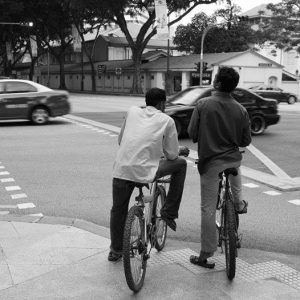Reframing the Malay Past in Singapore’s History
July 1, 2021

In “Reframing the Malay Past in Singapore’s History” (from Beyond Bicentennial Perspectives on Malays, published in July 2020), Associate Professor Sher Banu A.L. Khan (NUS Department of Malay Studies) writes about how Singapore’s history should be traced back to the 14th century, rather than only from 1918, which the PAP elite identified as the beginning of Singapore’s history in 1965. Furthermore, though Raffles was originally cited to be the founder of modern Singapore, he thought his work to be more of building upon the existing pre-1819 Malay world. Raffles’ imagining of Singapore in 1819 was one where Singapore would be the centre of the Malay world, connected by bonds between followers and rulers, rather than the modern port it ended up becoming.
A/P Khan relates about the importance of history in nation-building in order for national solidarity, cohesion, and a shared identity to be established. She assesses the role of the Malay past in forging a Singaporean identity and suggests that by integrating the Malay history, we will be able to create a more inclusionary national history as well as identify new bridges linking Singapore to regional and global history.
During the British colonial period, the British tried to categorise the ethnically and geographically diverse Malay-speaking group into a singular Malay race, due to their belief that “race” was an important scientific category. However, in 1931, the Malayan census which the British used to classify the population identified over seventy “races”. The British thus faced great difficulty trying to impose a rigid categorization onto the shifting and fluid community of people who did not passively absorb the British’s ideas but instead adopted, adapted, localized or rejected them according to their own needs.
A/P Khan stresses that a group’s representation of its history has a significant impact on its sense of identity and its response to new challenges. The misconception that Malays were marginalized and non-entrepreneurial has led to an at times, self-fulfilling stereotyping of the Malay community, since it appears as if the Malays have not shared similar histories with other communities such as the Chinese and Indians. Rather than remaining satisfied with an oversimplified narrative of the Malays, A/P Khan suggests this stereotypical narrative must be interrogated as to when and why it became the dominant view. A more complex, diverse and balanced narrative of the Malay community is crucial to avoid a biased group image, self-serving political agenda, and a narrow prescriptive approach in writing Malay history.
To facilitate better understanding to forge a nationally shared collective identity, other communities in Singapore should be educated about the historical perspective of the Malays as well. As A/P Khan highlights, the histories of the many communities in Singapore, no matter how small in numbers they are, should be layered and weaved into the writing of an inclusionary national history.
Read the full chapter here.
